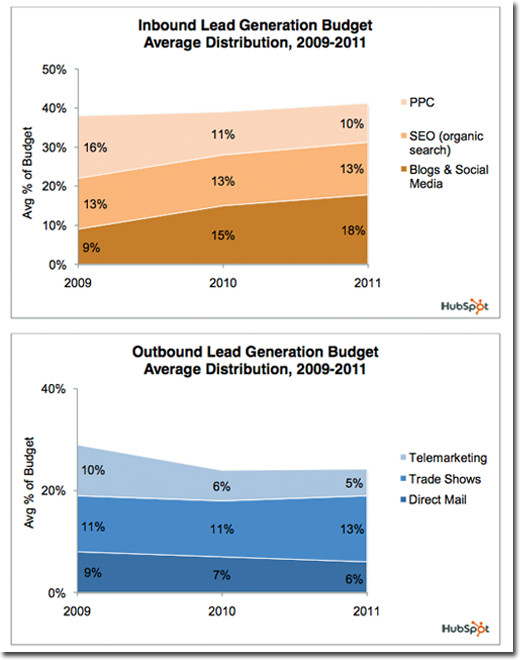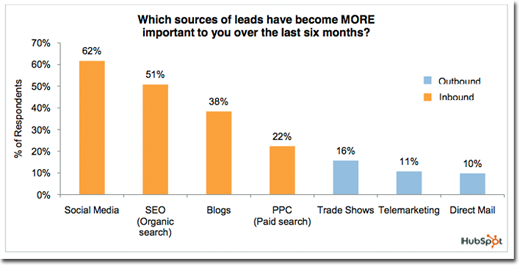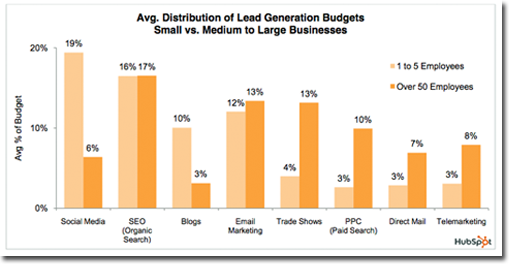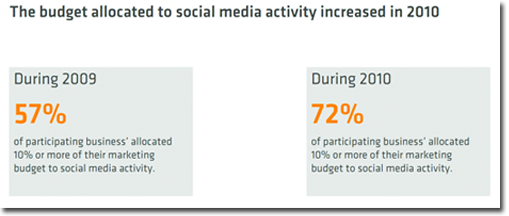
Over the course of the past few years, we’ve seen a dramatic rise in the usage of “non-traditional” marketing and customer service tools, primarily via social media. Be it a rapid response team ready to meet customer’s issues head on, or a marketing department that’s gone from a heavy reliance on outbound to a lead generating inbound strategy, social media is playing a key part. But what does this mean to the bottom line? If strategies and tactics are changing, shouldn’t the marketing budget allocation reflect these changes?
Small(er)
HubSpot’s 2011 State of Inbound Marketing Report covered a wide range of topics, but manages to separate out inbound marketing efforts including social media, company blogs, SEO, and PPC channels vs. outbound efforts including direct mail, telemarketing and trade shows. Email marketing can be used for both efforts, thus it receives its own category. Across the board, the HubSpot survey demonstrates that inbound marketing is taking a priority at the budget table, with the social media channel driving the charge. While PPC spend was down, SEO remained flat, and blog and social media spend increased by 9%, the single largest gain in all channels surveyed.

Likewise, when asked to rate specific channels within the overall inbound marketing program, 62% indicated that social media takes the top spot in their lead generating favorites.

Given the effectiveness, and relatively low cost of these channels, budgets have adjusted accordingly. For example, small businesses with 1-5 employees are allocating 18% of their lead generation spend to social media. In contrast, companies with 50+ employees allocate only 6% to the channel. If we look at the overall sum of the previously defined inbound and outbound channels, small businesses are dedicating almost half of their marketing spend towards inbound marketing efforts.

Medium(ish)
But let’s not just take HubSpot’s word for it, as metrics firm Nielsen has released a few figures of their own. Conducted in April of this year, Nielsen surveyed over 417 respondents, 83 of which indicated that they were working in a firm with over 100 staff members regarding their social media spend.
Of those surveyed, nearly half (42%) indicated that if they’ve already allocated a portion of their marketing spend to social media, they would increase this spend over the course of the year. Only 8% of those surveyed indicated that they would decrease social media spend.
In 2009, Nielsen asked what percentage of Australian businesses allotted 10% or more of their marketing budget to social media. Not surprisingly, the results indicated just over one half. Two years later, however, it seems as though that number has received a dramatic shift, with 72% of businesses surveyed indicating that more than 10% of their marketing budget is now social media focused.

Big(ger)
Rounding out the field, Altimeter’s Enterprise Level report seeks to address the social media spend in enterprise organizations (1,000+ employees) by surveying 140 corporate Social Strategists, and found that social business maturity drives social business spend. Meaning, investment in social media channels should be centered around Novice (internal organization), Intermediate (customer focused initiatives), and Advanced (enterprise wide social business integration).
Amongst the host of enterprise level gems in this survey, Altimeter points out that spending in 2011 is likely to increase within these organizations, noting that the average annual budget will amount to $278,000. This number represents a 48% increase in social business spending. Note this is social business, and not social media, as Altimeter includes soft costs such as training and staff to manage the social segment of their marketing program.
Overall, Altimeter’s recommendation to enterprise level businesses is that they match their social media budgeting allocation in accordance with their social business maturity level. Obviously, the higher up the chain, or deeper into the social pool you wade, the spend and investment should be reflected accordingly.
All-in-all, it would appear that organizations are no longer sitting on the fence, debating whether or not to jump on social media, and I believe the “it’s just a fad” argument can finally be put to bed. As we’ve seen in the three examples above, it’s no longer a question of are we jumping into the pool, but rather, how deep are we jumping, and what can I expect for my efforts?
How does your company spend stack up? Is your marketing department still targeting keywords that will eventually be blocked by AdBlocker, or are they investing in cultivating a brand conversation that reflects the overall goals of the organization as a whole?
For more on the social media swim, read our earlier article from today: Interview with Extole: How to turn your customers into social marketers.
Get the TNW newsletter
Get the most important tech news in your inbox each week.





